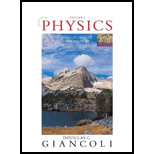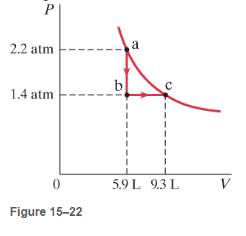
Physics: Principles and Applications -- Pearson e Text Instant Access (Pearson+)
7th Edition
ISBN: 9780137679065
Author: Douglas Giancoli
Publisher: PEARSON+
expand_more
expand_more
format_list_bulleted
Textbook Question
Chapter 15, Problem 10P
Consider the following two-step process. Heat is allowed toflow out of an ideal gas at constant volume so that its pressure drops from 2.2 atm to 1.4 atm. Then the gas expands at constant pressure, from a volume of 5.9 L to 9.3 L, where the temperature reaches its original value. See Fig. 15-22.Calculate (a) the total work done by the gas in the process, (b) the change in internal energy of the gas in the process, and (c) the total heat flow into or out of the gas.

Expert Solution & Answer
Want to see the full answer?
Check out a sample textbook solution
Students have asked these similar questions
E =
кедо
Xo
A continuous line of charge lies along the x axis, extending from x = +x to positive infinity. The line carries positive charge with a uniform linear charge density 10.
(a) What is the magnitude of the electric field at the origin? (Use the following as necessary: 10, Xo, and ke.)
(b) What is the direction of the electric field at the origin?
O O O O O O G
-y
+z
○ -z
+x
-x
+y
Include free body diagram
2 Spring 2025
-03
PITT
Calculate the acceleration of a skier heading down a 10.0° slope, assuming the coefficient of
cold coast at a constant velocity. You can neglect air resistance in both parts.
friction for waxed wood on wet snow fly 0.1 (b) Find the angle of the slope down which this skier
Given:
9 = ?
8=10°
4=0.1
Chapter 15 Solutions
Physics: Principles and Applications -- Pearson e Text Instant Access (Pearson+)
Ch. 15 - Prob. 1OQCh. 15 - hi an isothermal process, 3700 J of work is done...Ch. 15 - Prob. 2QCh. 15 - Prob. 3QCh. 15 - Prob. 4QCh. 15 - An ideal monatomic gas expands slowly to twice its...Ch. 15 - Prob. 6QCh. 15 - Prob. 7QCh. 15 - What are the high-temperature and the...Ch. 15 - Prob. 9Q
Ch. 15 - Prob. 10QCh. 15 - Prob. 11QCh. 15 - Prob. 12QCh. 15 - Prob. 13QCh. 15 - Prob. 14QCh. 15 - Prob. 15QCh. 15 - Prob. 16QCh. 15 - Prob. 17QCh. 15 - Prob. 18QCh. 15 - Prob. 19QCh. 15 - Prob. 20QCh. 15 - Prob. 1MCQCh. 15 - Prob. 2MCQCh. 15 - Prob. 3MCQCh. 15 - Prob. 4MCQCh. 15 - Prob. 5MCQCh. 15 - Prob. 6MCQCh. 15 - Prob. 7MCQCh. 15 - Prob. 8MCQCh. 15 - Prob. 9MCQCh. 15 - Prob. 10MCQCh. 15 - Prob. 11MCQCh. 15 - An ideal gas expands isothermally, performing 4.30...Ch. 15 - Prob. 2PCh. 15 - Prob. 3PCh. 15 - Prob. 4PCh. 15 - A 10-L volume of air initially at 3.5 atm of...Ch. 15 - Prob. 6PCh. 15 - Prob. 7PCh. 15 - Prob. 8PCh. 15 - Prob. 9PCh. 15 - Consider the following two-step process. Heat is...Ch. 15 - Prob. 11PCh. 15 - 12. (Ill) The PV diagram in Fig. 15-23 (? shows...Ch. 15 - Prob. 13PCh. 15 - Prob. 14PCh. 15 - Prob. 15PCh. 15 - Prob. 16PCh. 15 - (a) How much energy is transformed by a typical...Ch. 15 - A heat engine exhausts 8200 J of heat while...Ch. 15 - What is the maximum efficiency of a heat engine...Ch. 15 - The exhaust temperature of a heat engine is 230°C....Ch. 15 - Prob. 21PCh. 15 - A heat engine's high temperature T„ could be...Ch. 15 - Which will Improve the efficiency of a Carnot...Ch. 15 - Prob. 24PCh. 15 - Prob. 25PCh. 15 - Prob. 26PCh. 15 - Prob. 27PCh. 15 - Prob. 28PCh. 15 - Prob. 29PCh. 15 - A heat engine uses a heat source at580°Cand has an...Ch. 15 - A typical compact car experiences a total drag...Ch. 15 - If an ideal refrigerator keeps its contents at...Ch. 15 - Prob. 33PCh. 15 - Prob. 34PCh. 15 - Prob. 35PCh. 15 - Prob. 36PCh. 15 - Prob. 37PCh. 15 - Prob. 38PCh. 15 - Prob. 39PCh. 15 - Prob. 40PCh. 15 - What is the change in entropy of 1.00 m3of water...Ch. 15 - Prob. 42PCh. 15 - Prob. 43PCh. 15 - Prob. 44PCh. 15 - Prob. 45PCh. 15 - Prob. 46PCh. 15 - Prob. 47PCh. 15 - Prob. 48PCh. 15 - Prob. 49PCh. 15 - Suppose that you repeatedly shake six coins in...Ch. 15 - Prob. 51PCh. 15 - Prob. 52PCh. 15 - Prob. 53PCh. 15 - Prob. 54PCh. 15 - Prob. 55PCh. 15 - Prob. 56GPCh. 15 - When 5.80 x 105J of heat is added to a gas...Ch. 15 - Prob. 58GPCh. 15 - Prob. 59GPCh. 15 - Prob. 60GPCh. 15 - Prob. 61GPCh. 15 - Prob. 62GPCh. 15 - Prob. 63GPCh. 15 - Prob. 64GPCh. 15 - Prob. 65GPCh. 15 - The burning of gasoline in a car releases about...Ch. 15 - Prob. 67GPCh. 15 - Calculate the work done by an ideal gas in going...Ch. 15 - Prob. 69GPCh. 15 - Suppose a power plant delivers energy at 880 MW...Ch. 15 - Prob. 71GPCh. 15 - Prob. 72GPCh. 15 - Prob. 73GPCh. 15 - Prob. 74GPCh. 15 - Prob. 75GPCh. 15 - Prob. 76GPCh. 15 - Prob. 77GP
Knowledge Booster
Learn more about
Need a deep-dive on the concept behind this application? Look no further. Learn more about this topic, physics and related others by exploring similar questions and additional content below.Similar questions
- dry 5. (a) When rebuilding her car's engine, a physics major must exert 300 N of force to insert a c piston into a steel cylinder. What is the normal force between the piston and cyli=030 What force would she have to exert if the steel parts were oiled? k F = 306N 2 =0.03 (arrow_forwardInclude free body diagramarrow_forwardInclude free body diagramarrow_forward
- Test 2 МК 02 5. (a) When rebuilding her car's engine, a physics major must exert 300 N of force to insert a dry = 0.03 (15 pts) piston into a steel cylinder. What is the normal force between the piston and cylinder? What force would she have to exert if the steel parts were oiled? Mk Giren F = 306N MK-0.3 UK = 0.03 NF = ?arrow_forward2. A powerful motorcycle can produce an acceleration of 3.50 m/s² while traveling at 90.0 km/h. At that speed the forces resisting motion, including friction and air resistance, total 400 N. (Air resistance is analogous to air friction. It always opposes the motion of an object.) What force does the motorcycle exert backward on the ground to produce its acceleration if the mass of the motorcycle with rider is 245 ke? a = 350 m/s 2arrow_forward2. A powerful motorcycle can produce an acceleration of 3.50 m/s² while traveling at 90.0 km/h. At that speed the forces resisting motion, including friction and air resistance, total 400 N. (Air resistance is analogous to air friction. It always opposes the motion of an object.) What force does the motorcycle exert backward on the ground to produce its acceleration if the mass of the motorcycle with rider is 245 kg? (10 pts) a = 3.50 m/s 2 distance 90 km/h = 3.50m/62 M = 245garrow_forward
- Using Table 17-4, determine the approximate temperature of metal that has formed a dark blue color.arrow_forwardA positively charged disk has a uniform charge per unit area σ. dq R P x The total electric field at P is given by the following. Ek [2 - x (R² + x2) 1/2 Sketch the electric field lines in a plane perpendicular to the plane of the disk passing through its center.arrow_forwardConsider a closed triangular box resting within a horizontal electric field of magnitude E = 8.02 104 N/C as shown in the figure below. A closed right triangular box with its vertical side on the left and downward slope on the right rests within a horizontal electric field vector E that points from left to right. The box has a height of 10.0 cm and a depth of 30.0 cm. The downward slope of the box makes an angle of 60 degrees with the vertical. (a) Calculate the electric flux through the vertical rectangular surface of the box. kN · m2/C(b) Calculate the electric flux through the slanted surface of the box. kN · m2/C(c) Calculate the electric flux through the entire surface of the box. kN · m2/Carrow_forward
- The figure below shows, at left, a solid disk of radius R = 0.600 m and mass 75.0 kg. Tu Mounted directly to it and coaxial with it is a pulley with a much smaller mass and a radius of r = 0.230 m. The disk and pulley assembly are on a frictionless axle. A belt is wrapped around the pulley and connected to an electric motor as shown on the right. The turning motor gives the disk and pulley a clockwise angular acceleration of 1.67 rad/s². The tension T in the upper (taut) segment of the belt is 145 N. (a) What is the tension (in N) in the lower (slack) segment of the belt? N (b) What If? You replace the belt with a different one (one slightly longer and looser, but still tight enough that it does not sag). You again turn on the motor so that the disk accelerates clockwise. The upper segment of the belt once again has a tension of 145 N, but now the tension in the lower belt is exactly zero. What is the magnitude of the angular acceleration (in rad/s²)? rad/s²arrow_forwardA bridge truss extends x = 217 m across a river (shown in the figure below) where 0 = 40°. The structure is free to slide horizontally to permit thermal expansion. The structural components are connected by pin joints, and the masses of the bars are small compared with the mass of a 1300 kg car at the center. Calculate the force of tension or compression in each structural component (in N). B D T T T T T 22820 AB AC BC ||| || || || BD N ---Select--- N ---Select--- N ---Select--- N ---Select--- DE N ---Select--- T DC= N ---Select--- TEC N ---Select--- с ✓ Earrow_forwardno ai pleasearrow_forward
arrow_back_ios
SEE MORE QUESTIONS
arrow_forward_ios
Recommended textbooks for you
 Physics for Scientists and Engineers: Foundations...PhysicsISBN:9781133939146Author:Katz, Debora M.Publisher:Cengage Learning
Physics for Scientists and Engineers: Foundations...PhysicsISBN:9781133939146Author:Katz, Debora M.Publisher:Cengage Learning Principles of Physics: A Calculus-Based TextPhysicsISBN:9781133104261Author:Raymond A. Serway, John W. JewettPublisher:Cengage Learning
Principles of Physics: A Calculus-Based TextPhysicsISBN:9781133104261Author:Raymond A. Serway, John W. JewettPublisher:Cengage Learning
 Physics for Scientists and Engineers, Technology ...PhysicsISBN:9781305116399Author:Raymond A. Serway, John W. JewettPublisher:Cengage Learning
Physics for Scientists and Engineers, Technology ...PhysicsISBN:9781305116399Author:Raymond A. Serway, John W. JewettPublisher:Cengage Learning College PhysicsPhysicsISBN:9781285737027Author:Raymond A. Serway, Chris VuillePublisher:Cengage Learning
College PhysicsPhysicsISBN:9781285737027Author:Raymond A. Serway, Chris VuillePublisher:Cengage Learning Physics for Scientists and EngineersPhysicsISBN:9781337553278Author:Raymond A. Serway, John W. JewettPublisher:Cengage Learning
Physics for Scientists and EngineersPhysicsISBN:9781337553278Author:Raymond A. Serway, John W. JewettPublisher:Cengage Learning

Physics for Scientists and Engineers: Foundations...
Physics
ISBN:9781133939146
Author:Katz, Debora M.
Publisher:Cengage Learning

Principles of Physics: A Calculus-Based Text
Physics
ISBN:9781133104261
Author:Raymond A. Serway, John W. Jewett
Publisher:Cengage Learning


Physics for Scientists and Engineers, Technology ...
Physics
ISBN:9781305116399
Author:Raymond A. Serway, John W. Jewett
Publisher:Cengage Learning

College Physics
Physics
ISBN:9781285737027
Author:Raymond A. Serway, Chris Vuille
Publisher:Cengage Learning

Physics for Scientists and Engineers
Physics
ISBN:9781337553278
Author:Raymond A. Serway, John W. Jewett
Publisher:Cengage Learning
The Second Law of Thermodynamics: Heat Flow, Entropy, and Microstates; Author: Professor Dave Explains;https://www.youtube.com/watch?v=MrwW4w2nAMc;License: Standard YouTube License, CC-BY